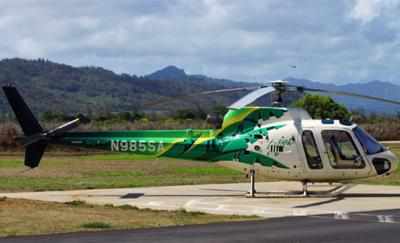Fri, May 13, 2022
NTSB Alleges FAA Could Have Prevented Tour Helicopter Crash
Earlier this week, the National Transportation Safety Board (NTSB) alleged that the Federal Aviation Administration (FAA) was negligent in preventing the fatal crash of an Air Tour Helicopter in 2019.

On 26 December 2019, an Airbus AS350 B2 helicopter that was being used for Air Tours by Safari Aviation crashed in Kekaha, Hawaii, killing the pilot and all six passengers after possibly entering instrument meteorological conditions (IMC).
The NTSB stated that as early as 2013, they emphasized [to the FAA] the need for more ‘flight information’ that they [NTSB] could use in possibly reconstructing the factors involved in accidents, and in drafting operating recommendations to avoid future recurrences. The NTSB also cited a general lack of up-to-date weather conditions, information about unusual/atypical weather, and lack of specialized in-flight weather training for air tour operators as factors that could have avoided the fatal crash of 2019.
Investigators stated that the air tour pilot was highly experienced who also served as the air tour company’s Chief Pilot and Check Airman, and still managed to get himself into a situation from which he could not recover. The terrain interference coupled with sparseness of weather observation systems, subsequently spotty radio communications and flight-tracking leaves a lot up to the pilot to evaluate as they go. You may recall the Civil Air Patrol crash on 29 March 2022 which had departed Lihue Airport and met its fatal end with two pilots aboard some 13 miles north in Kekhana. According to eyewitnesses, deteriorating weather was a contributing factor.
In the authors opinion, the NTSB appears to be using this incident to again push for the installation of flight data recorders. While the data recorders are good for evaluating after the crash, a more pressing need, it seems is the availability of real-time weather, information sharing, and training/awareness for the atypical/unusual weather common to the area.
More News
Aero Linx: Model Aeronautical Association of Australia MAAA clubs are about fun flying, camaraderie and community. For over 75 years, the MAAA has been Australia’s largest fl>[...]
Touchdown Zone Lighting Two rows of transverse light bars located symmetrically about the runway centerline normally at 100 foot intervals. The basic system extends 3,000 feet alon>[...]
“Discovery and innovation are central to our mission at Virgin Galactic. We’re excited to build on our successful record of facilitating scientific experiments in subor>[...]
How To Get A Story On Aero-TV News/Feature Programming How do I submit a story idea or lead to Aero-TV? If you would like to submit a story idea or lead, please contact Jim Campbel>[...]
Student Pilot Reported That During Rotation, “All Of A Sudden The Back Of The Plane Kicked To The Right..." Analysis: The student pilot reported that during rotation, “>[...]
 ANN's Daily Aero-Linx (05.02.24)
ANN's Daily Aero-Linx (05.02.24) ANN's Daily Aero-Term (05.02.24): Touchdown Zone Lighting
ANN's Daily Aero-Term (05.02.24): Touchdown Zone Lighting Aero-News: Quote of the Day (05.02.24)
Aero-News: Quote of the Day (05.02.24) ANN FAQ: Contributing To Aero-TV
ANN FAQ: Contributing To Aero-TV NTSB Final Report: Cirrus Design Corp SR20
NTSB Final Report: Cirrus Design Corp SR20



